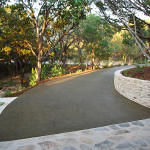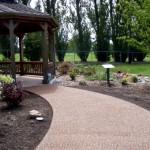Stormwater runoff occurs when rain or snow land on any solid impervious surface such as sidewalks, parking lots, and roofs. The stormwater, or melted snow, must travel to a place that will absorb it .
Why is stormwater runoff a problem?
Stormwater runoff is one of the largest single contributor of pollutants to our water systems. Water that travels along solid surfaces pick up pollutants such as oil, fertilizers, and pesticides and carry them into streams and other inlets.
As urban areas grow so does the amount of impervious surface. This increases the amount of stormwater looking for a place to go. If the water has nowhere to go flooding can occur. Flooding creates safety problems for the public and causes erosion to the surrounding environment.
Current development practices create a lot of impervious surfaces and place a burden on existing stormwater systems.
How do I prevent stormwater runoff pollution?
Low impact development (LID) is the practice of developing real estate that works with nature to manage stormwater as close to the source as possible.
Rooftop gardens, rain gardens, and pervious surfaces all help manage stormwater runoff. Vegetative rooftop gardens collect and use the water that would normally run off a roof. Rain gardens act as collection points for stormwater that help filter out pollutants. Pervious surfaces allow water to flow directly through them into either a storage system or system that delivers the water into the ground at a controlled rate. FilterPave, porous asphalt, pervious concrete, and porous pavers are the most common pervious surfaces.
- International Crane Foundation
- Filterpave driveway
- Evergreen Arboretum -WA
Testing by the University of Central Florida determined FilterPave the most effective porous surface for managing stormwater . FilterPave has over twice the sustainable void space of porous asphalt or concrete and four times the void space of pervious pavers. This allows for more water flow and less clogging.


